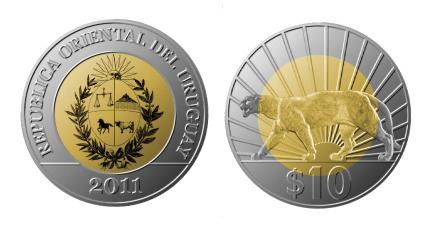Code UYU Symbol $ or $U Rarely used $50 | 1/100 centésimo Freq. used $1, $2, $5, $10 | |
 | ||
Banknotes $20, $50, $100, $200, $500, $1000, $2000 | ||
Uruguayan peso has been a name of the Uruguayan currency since Uruguay's settlement by Europeans. The present currency, the peso uruguayo (ISO 4217 code: UYU) was adopted in 1993 and is subdivided into 100 centésimos.
Contents
Introduction
Uruguay obtained monetary stability in 1896, based on the gold standard. This favorable state of affairs ended after World War I. An unsettled period followed. Economic difficulties after World War II produced inflation, which became serious after 1964 and continued into the 1970s.
The peso was replaced on 1 July 1975 by the nuevo peso (new peso; ISO 4217 code: UYN) at a rate of 1 new peso for 1000 old pesos. The nuevo peso was also subdivided into 100 centésimos.
After further inflation, the peso uruguayo (ISO 4217 code: UYU) replaced the nuevo peso on March 1, 1993, again at a rate of 1 new for 1000 old.
Inflation
Uruguayans became accustomed to the constant devaluation of their currency. Uruguayans refer to periods of real appreciation of the currency as atraso cambiario, which literally means that "the exchange rate is running late". As a consequence of the instability of the local currency, prices for most big-ticket items (real estate, cars and even executives' salaries) are denominated in U.S. dollars.
During the military rule, the peso was on a crawling peg to the dollar. A table of the future value of the dollar was published daily by the government (called the tablita). In 1982, the currency was devalued ("the tablita was broken"), throwing thousands of companies and individuals into bankruptcy. In the 1990s, a new mechanism to provide predictability was introduced, this time in the form of a sliding range, with top and bottom margins, at which the government would intervene. In 2002, after a banking crisis and amid a huge budget deficit, the currency was again allowed to float, losing almost 50% of its value in a couple of weeks, and, again, throwing into bankruptcy thousands of companies and individuals who held debts denominated in US dollars.
In 2004 a phenomenon completely new to most Uruguayans developed: the currency appreciated in nominal terms against the US dollar, going from 30 to 24 pesos to the dollar. By 2008 the peso reached 19 to the US dollar, recovering more than half of its loss during the crisis. This revaluation brought protests from the industrial sector, which felt that it lost competitiveness. The government hopes that a floating currency will "de-dollarize" the economy. Uruguay does not seem to have found a mechanism that provides the exchange rate some level of predictability, while at the same time allowing the country to adapt its prices so that its exports remain competitive.
Coins
In 1994, stainless-steel 10, 20 and 50 centésimos and brass 1 and 2 pesos uruguayos were introduced. 5 and 10 pesos uruguayos were introduced in 2003 and 2000, respectively. The coins replaced same value notes. Coins in circulation are:
In July 2010, 50 centésimos coins were withdrawn from circulation.
New 1, 2, 5, and 10 pesos coins were introduced in January 2011.
